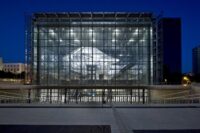- Home
- Articles
- Architectural Portfolio
- Architectral Presentation
- Inspirational Stories
- Architecture News
- Visualization
- BIM Industry
- Facade Design
- Parametric Design
- Career
- Landscape Architecture
- Construction
- Artificial Intelligence
- Sketching
- Design Softwares
- Diagrams
- Writing
- Architectural Tips
- Sustainability
- Courses
- Concept
- Technology
- History & Heritage
- Future of Architecture
- Guides & How-To
- Art & Culture
- Projects
- Interior Design
- Competitions
- Jobs
- Store
- Tools
- More
- Home
- Articles
- Architectural Portfolio
- Architectral Presentation
- Inspirational Stories
- Architecture News
- Visualization
- BIM Industry
- Facade Design
- Parametric Design
- Career
- Landscape Architecture
- Construction
- Artificial Intelligence
- Sketching
- Design Softwares
- Diagrams
- Writing
- Architectural Tips
- Sustainability
- Courses
- Concept
- Technology
- History & Heritage
- Future of Architecture
- Guides & How-To
- Art & Culture
- Projects
- Interior Design
- Competitions
- Jobs
- Store
- Tools
- More
Creating Inviting Public Spaces: Architectural Insights for Community-Friendly Designs
Discover how architects transform public spaces into vibrant, inclusive hubs that foster community connection and cultural identity. Explore design insights balancing aesthetics, accessibility, and functionality, while embracing sustainability and innovation to create welcoming environments for relaxation, interaction, and growth in modern urban landscapes.

Public spaces shape the heart of our communities, offering places where people connect, relax, and thrive. But what makes a public space truly inviting? It’s more than just aesthetics—it’s about creating environments that feel welcoming, functional, and inclusive for everyone.
As architects and designers, we hold the keys to transforming ordinary spaces into vibrant hubs of activity. By blending thoughtful design principles with a deep understanding of human behavior, we can craft public spaces that inspire interaction and foster a sense of belonging. Let’s explore the architectural insights that bring these spaces to life.

Table of Contents
ToggleUnderstanding Inviting Public Spaces
Creating inviting public spaces involves balancing aesthetics, accessibility, and functionality. These areas foster community engagement and contribute to cultural and social cohesion.
The Importance of Public Spaces
Public spaces serve as communal hubs where individuals interact, connect, and engage. They enhance quality of life by offering environments for recreation, reflection, and socialization. Well-designed public areas also support local economies by attracting visitors, boosting foot traffic, and hosting events. For example, parks, plazas, and pedestrian-friendly streets often become iconic landmarks within cities.
By integrating inclusive design principles, public spaces address diverse needs, ensuring access for individuals across all demographics, including age, mobility, and economic background. This inclusivity strengthens community ties and promotes equal opportunities for participation.
Key Elements of Inviting Architectural Design
Designing inviting public spaces requires attention to layout, features, and user experience.
- Accessibility: Spaces must accommodate a range of users. Features like ramps, tactile walkways, and adequate signage improve access.
- Aesthetics: Elements such as landscaping, lighting, and art installations enhance visual appeal. A well-designed green space, for instance, can transform an urban area into a serene retreat.
- Functionality: Layouts should support varied activities. Multifunctional zones, like spaces that combine seating, walking paths, and play areas, encourage greater usage.
- Connectivity: Seamless integration with surrounding infrastructure enhances accessibility. Connected pathways, public transport links, and parking facilities create cohesion.
- Safety: Clear sightlines, lighting, and open designs foster a sense of security. For example, designing well-lit paths in parks can reduce isolated zones.
Attention to these elements ensures public spaces remain inviting, accessible, and engaging for all visitors.

Architectural Principles for Public Spaces
Architectural principles guide the creation of public spaces that are functional, inclusive, and visually engaging. These principles ensure environments that foster interaction, community, and a strong sense of identity.
Balancing Functionality and Aesthetic Appeal
Designing public spaces merges practicality with visual harmony. Functional layouts prioritize clear pathways, versatile seating, and spaces for diverse activities. Aesthetic elements, including sculptures, murals, and dynamic lighting, enhance the ambiance while maintaining usability. For example, pedestrian plazas often combine seamless walkways with vibrant art installations to create welcoming environments.
Incorporating Nature and Open Spaces
Natural elements improve public spaces, offering relaxation and ecological benefits. Parks, green roofs, and water features introduce restorative qualities while mitigating urban heat. Open spaces, such as grass areas or tree-shaded zones, support gatherings, exercise, and informal events. Spaces like urban squares with integrated green zones balance modern infrastructure with nature.
Accessibility and Inclusivity as Design Priorities
Designs that prioritize accessibility cater to individuals of all abilities. Features like wheelchair ramps, spacious pathways, and braille signage aid usability. Inclusivity extends to seating arrangements, sensory-friendly zones, and multilingual information displays. Spaces like community centers leverage universal design to ensure equitable access for everyone.

Designing for Community Engagement
Effective design fosters connections among individuals, enabling vibrant interactions and a stronger sense of belonging. Architectural strategies enhance accessibility, cultural resonance, and community-focused functionality.
Encouraging Social Interaction Through Layout
Strategic layouts promote natural gathering points and fluid movement. Open-plan designs, for instance, allow flexible usage while ensuring clear sightlines to enhance visibility. Arranging seating in circular or semi-circular formations encourages face-to-face communication, fostering interpersonal connections. Incorporating multipurpose zones supports diverse activities, such as recreational play, casual networking, or community events. Pathways should be intuitive, guiding visitors seamlessly while discouraging isolation. Spaces that balance intimacy and openness foster both small-group discussions and larger social interactions.
Integrating Local Culture and Identity
Architectural designs grounded in local heritage amplify a community’s unique character. Incorporating traditional motifs, local materials like regional stone or wood, and public art by local artists strengthens residents’ connections to the space. Highlighting indigenous plants in landscaping or historical references through interactive installations establishes cultural continuity. Naming spaces or features after regionally significant individuals or events further anchors the area to its roots. Community consultation during the design phase ensures the space authentically reflects local identity, resonating with its users.
Innovative Architectural Trends in Public Spaces
Architectural advancements are redefining public spaces, focusing on sustainability, technology, and multifunctionality. These trends enhance usability while addressing modern urban challenges.
Smart Technologies and Sustainability
We incorporate smart technologies to improve functionality and sustainability in public areas. Solar panels, energy-efficient lighting, and automated systems reduce environmental impact. For example, smart benches with charging ports and sensors monitor environmental conditions, enhancing user convenience while promoting eco-conscious design.
Sustainable materials like reclaimed wood, recycled plastic, and low-carbon concrete are increasingly common. Adding green infrastructure, such as rain gardens and living walls, supports biodiversity and manages stormwater effectively. These elements ensure public spaces align with environmental goals while meeting urban functionality.
Multifunctional Spaces for Diverse Activities
Public spaces now accommodate multiple activities to maximize community usage. Flexible layouts enable hosting activities like outdoor yoga, live performances, and farmers’ markets in the same area. For instance, retractable seating and modular furniture allow adaptive use, ensuring spaces remain relevant for various events and gatherings.
Creating zones for passive and active uses fosters inclusivity. Integrating play areas, quiet zones, and communal workspaces allows individuals of all ages and interests to coexist harmoniously. By focusing on multifunctionality, we ensure these spaces remain vibrant and well-utilized.

Challenges in Creating Inviting Public Spaces
Designing inviting public spaces requires addressing complex constraints that affect functionality, inclusivity, and community engagement. Architects and planners must navigate diverse challenges to ensure these spaces meet users’ needs while maintaining long-term appeal.
Addressing Urban Density and Space Limitations
High urban population densities often restrict available land for public spaces. This limitation necessitates innovative design solutions, such as vertical green spaces, rooftop parks, and multi-use areas. Compact designs can maximize functionality by combining recreational zones, seating areas, and walkways into a smaller footprint. Connecting these spaces to existing infrastructure through pedestrian bridges or integrated transit hubs ensures accessibility. In dense urban areas, aligning design with zoning regulations while preserving natural elements further complicates development.
Overcoming Maintenance and Operational Issues
Public spaces face ongoing challenges related to upkeep and functionality. Costs associated with landscaping, lighting, and cleaning can strain budgets, especially for municipal administrators. Durability-focused designs, like using weather-resistant materials for benches and structures, reduce maintenance demands. Deploying smart technologies, such as automated lighting or irrigation systems, can enhance efficiency. Addressing vandalism and safety requires balanced solutions, like incorporating vandal-resistant finishes while improving oversight through minimal but effective surveillance measures. Ensuring community partnerships or volunteers support these efforts promotes shared responsibility for space upkeep.
Conclusion
Inviting public spaces rely on thoughtful architectural strategies that prioritize accessibility, aesthetics, and functionality. By integrating inclusive design principles, sustainable practices, and community-centric elements, we can create environments that foster connection and cultural identity. Effective layouts, local influences, and adaptive features ensure these spaces remain flexible and engaging while addressing urban demands and maintenance challenges. Through collaboration and innovation, we enhance public areas, making them vibrant hubs for interaction, reflection, and growth.
- and outdoor community spaces design
- architects for public spaces
- architectural design for public spaces
- architectural insights
- architecture for community spaces
- community architecture
- community planning and design
- community-driven architecture
- community-driven design
- community-friendly design
- designing for communities
- designing inclusive spaces
- designing public environments
- inclusive public spaces
- outdoor public spaces
- placemaking architecture
- public space architecture
- Public Space Design
- public space planning
- sustainable public spaces
- urban design
- urban design services
- urban public spaces
Submit your architectural projects
Follow these steps for submission your project. Submission FormLatest Posts
Enhancing Urban Life: Best Practices for the Design of Walkways in Urban Areas
Discover the transformative role of urban walkway design in creating safer, sustainable,...
Playgrounds: Landscape Architecture for Inviting Interaction
Playgrounds in landscape architecture are more than spaces for activity—they are environments...
Future Trends in Urban Development: Embracing Sustainability and Smart Technology
Explore the future of urban development in this insightful article that highlights...
Understanding Having an Architectural Perception in Public Spaces for Better Community Engagement
Explore the transformative power of architectural perception in public spaces. This article...












Leave a comment